Click On Image
For Full Size Image |
Size |
Image Description |
Contributed
By And/Or Copyright |
Name
|

NS0306505 |
127k |
CVE-65 was initially named Dolomi Bay for a bay
on the southeast coast of Prince of Wales Island, Alexander Archipelago, Alaska (NS0306505).
Renamed Wake Island, 3 April 1943, after an atoll in the northern Pacific, consisting
of three islands (Wake, Peale, and Wilkes) which became an American advanced base in 1941 (NS0306505a).
At the time of the Japanese attack on Pearl Harbor on 7 December 1941 (8 December on Wake), all naval
activities at the atoll were under CDR Winfield S. Cunningham, United States Navy; under his overall
command were the 13 officers and 365 enlisted men of the 1st Defense Battalion, United States Marine
Corps, commanded by Maj. James P.S. Devereaux, United States Marine Corps, whose heaviest guns were
5-inch/51-caliber rifles once mounted in old battleships. A Marine fighter squadron, dispatched at
the "eleventh hour," reached Wake only a few days before the Japanese attack; that unit, consisting
of 12 Grumman F4F-3 Wildcat fighters from Marine Fighter Squadron (VMF) 211, was commanded by
Maj. Paul A. Putnam, USMC. Also on Wake were 1,000 civilian construction workers employed by Contractors,
Pacific, Naval Air Bases, and a small Army communication detachment.
Although the atoll went to general quarters upon hearing of the Pearl Harbor attack, a combination
of a lack of radar, loud surf noises (which made sound-detectors practically useless), and heavy cloud
cover rendered it possible for the Japanese to achieve a surprise attack shortly before noon on 8 December.
Twenty-seven planes emerged from the low-hanging clouds and bombed and strafed the airfield, destroying
seven of VMF-211's F4F-3s and killing or wounding 62 percent of the aviation personnel on the island.
Over the next two weeks, the Japanese bombed Wake almost incessantly, softening up the atoll for
invasion. The first attempt met with failure on 11 December, when shore batteries and VMF-211's remaining
F4F-3s sank two Japanese destroyers, Kisaragi
and Hayate.
The setback suffered on 11 December forced the Japanese to bring up reinforcements, including two
of the homeward-bound Pearl Harbor striking force carriers, and carrier-based planes began hitting
the atoll on 21 December. The following day, the last two flyable Wildcats (there had never
been more than four operational over the two-week defense of Wake) went up to do battle with Japanese.
One crippled Wildcat returned, so badly shot-up that it was un-useable.
With the aviation element now disposed of, the Japanese felt confident that they could land. Accordingly,
at 0200 on 23 December 1941, the enemy managed to establish a beachhead, running two old destroyer-transports
ashore in the process under heavy gunfire. After bitter fighting, the men of the Japanese Special
Naval Landing Force managed to overcome the defending Marines but not without sustaining heavy casualties.
Wilkes was the last island to surrender, on the afternoon of the 23rd.
NS0306505b: Imperial Japanese Navy destroyer Hayate running trials,
circa 1925. Hayate was sunk during the Battle of Wake Island, on 11 December 1941, the first
Japanese surface warship sunk in the war; only one man of her crew was rescued.
(Maps NS0306505 and NS0306505a courtesy of Google
Maps. Photo NS0306505b from History of Japanese Destroyers, published
by Kaigunsha.) |
NavSource |
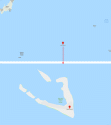
NS0306505a |
35k |

NS0306505b |
341k |
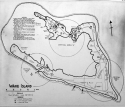
NS0306505c |
628k |
Diagram of Wake Island, February 1942.
Official U.S. Navy Photograph, now in the collections of the National
Archives and Records Administration (NARA), # 80-G-466235. |
NARA |
Construction
|

NS0306509 |
112k |
Christening of the future USS Wake Island (CVE-65), Wednesday,
15 September 1943. Her sponsor was Fanny Jessop Sherman, wife of then RADM Frederick C. Sherman, Commander,
Carrier Division 2, who had been the commanding officer of USS Lexington
(CV-2), sunk at the Battle of the Coral Sea.
Press photo. |
S. Dale Hargrave |
World War II
|

NS0306501 |
48k |
Small, port side view taken on November 9, 1944. |
USN |
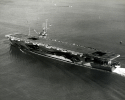
NS0306501a |
468k |
USS Wake Island (CVE-65) underway in Hampton Roads, Virginia,
9 November 1944. Photographed from a plane based at Naval Air Station, Norfolk, Virginia. The ship
is painted in Camouflage Measure 33, Design 10A.
Official U.S. Navy photograph, from the collections of the Naval
History and Heritage Command (NH&HC), # NH 106569. |
Robert Hurst |

NS0306501b |
55k |
USS Wake Island (CVE-65) underway in Hampton Roads, Virginia,
9 November 1944.
National Archives photo (# 80-G-289882). |
Tracy White, Researcher @ Large |

NS0306501c |
93k |
The escort carrier USS Wake Island (CVE-65) underway on 9 November
1944. Note the HF/DF mast for North Atlantic ASW and the flat hangar deck, indicated by the straight
line of the outboard sponsons. The prominent hangar-deck sponsons were used primarily for refueling
at sea, CVEs carrying substantial loads of cargo oil for destroyers and destroyer escorts. USN photo.
Photo and text from U.S.
Aircraft Carriers: An Illustrated Design History, by Norman Friedman. |
Robert Hurst |

NS0306501d |
444k |
Port broadside view of USS Wake Island (CVE-65) underway in
the Hampton Roads, Virginia, area, 9 November 1944. Photographed by N.A.S. Norfolk.
National Archives and Records Administration (NARA) photo
(# 80-G-289879). |
Mike Green |

NS0306501d1 |
231k |
Cropped version of photo above, colorized by Yu Chu. |
Yu Chu |

NS0306501e |
177k |
Overhead port bow view of USS Wake Island (CVE-65) underway
in the Hampton Roads, Virginia, area, 9 November 1944. Photographed by N.A.S. Norfolk.
National Archives and Records Administration (NARA) photo
(# 80-G-289880). |
Mike Green |

NS0306501f |
532k |
USS Wake Island (CVE-65) at Norfolk on 9 November 1944, wearing
Camouflage 33/10A. The colors are navy blue, haze gray and pale gray. This photo was taken by NAS
Norfolk.
United States National Archives and Records Administration
(NARA), Photo No. 80-G-289876. |
Courtesy of C. Lee Johnson, usndazzle.com,
via
Mike Green |

NS0306501g |
119k |
USS Wake Island (CVE-65), head-on, Norfolk Navy Yard, Photo
Serial 8868(44), Nov. 9, 1944. |
G. Verner,
via Yu Chu |

NS0306501h |
142k |
USS Wake Island (CVE-65), stern, Norfolk Navy Yard, Photo Serial
8872(44), Nov. 9, 1944. |
Yu Chu |
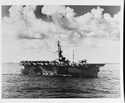
NS0306502 |
212k |
USS Wake Island (CVE-65) underway with Task Group 77.4, en
route to the Lingayen Gulf landings, 5 January 1945. Photographed from USS Makin
Island (CVE-93). Note high frequency direction finder (HFDF) antenna atop her small foremast.
Camouflage Measure 33, Design 10A (thanks to Aryeh Wetherhorn).
National Archives and Records Administration (NARA) photo
(# 80-G-301306). |
Tommy Trampp
Larger copy submitted by Mike Green |

NS0306506 |
917k |
Kamikaze attack on USS Helm
(DD-388). Plane was shot down and crashed into sea. Portside of ship, off Luzon, Philippines, approximately
17:15. Photograph by USS Wake Island (CVE-65), released 5 January 1945.
Official U.S. Navy photograph, now in the collections of the National
Archives and Records Administration (NARA), # 80-G-273082. |
NARA |
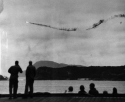
NS0306508 |
2.05M |
Four-photo series showing a Japanese plane going down off Okinawa
while attempting to attack USS Wake Island (CVE-65), 3 April 1945, during the Okinawa
Campaign. This Zero is possibly one of the two that attacked the escort carrier on that date.
Photographs taken from USS Tulagi (CVE-72) by Photographer's Mate First
Class C.G. Gemmil.
NS0306508: National Archives
and Records Administration (NARA) photo # 80-G-339259. First photo in series.
NS0306508a: National Archives
and Records Administration (NARA) photo # 80-G-339260. Second photo in series.
NS0306508b: National Archives
and Records Administration (NARA) photo # 80-G-339261. Third photo in series.
NS0306508c: National Archives
and Records Administration (NARA) photo # 80-G-339262. Fourth photo in series.
NS0306508c1: Same as NS0306508c, colorized by Yu
Chu. |
Via Yu Chu |
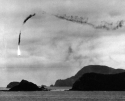
NS0306508a |
426k |
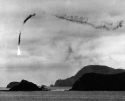
NS0306508b |
468k |
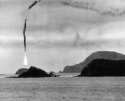
NS0306508c |
377k |
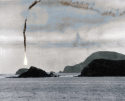
NS0306508c1 |
110k |

NS0306504 |
367k |
USS Wake Island (CVE-65) underway, in a photo dated 24 June
1945. The escort aircraft carrier had been detached "from TG 32.1 due to battle damage received on
3 April [(kamikaze)] and a subsequent finding by the Bureau of Ships that
'pending yardwork, this vessel is considered unsafe for operations in a forward area.' She headed for
Guam and conducted firing practices and launched LASP sorties en route. Upon her arrival at Port Apra
on 24 June, all personnel of squadron VOC-1 were transferred to Naval Air Base, Agana." (Quoted from DANFS.)
National Naval Aviation Museum Photo,
No.1996.488.034.016. Robert L. Lawson Photograph Collection. |
Mike Green |

NS0303047 |
325k |
Unusual to be seen up the Hudson River. This is ex-USS Charger
(CVE-30), left, and ex-USS Wake Island (CVE-65), right, in the Hudson River, MARAD berthing
anchorage, around April 1946. They were slated for disposal at decommissioning.
From a MARAD photo set of Dave Schroeder. |
Dave Schroeder
and John Chiquoine |
Memorabilia
|

NS0306503 |
56k |
Thanksgiving Day dinner menu, Thursday, November 25, 1943. |
USN |

NS0306507 |
256k |
USS Wake Island (CVE-65) patch. |
Tommy Trampp |
For more photos and information about this ship, see:
|


























